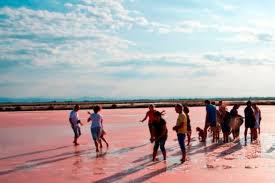Birdwatching in Cervia
Birdwatching: The salt pan of Cervia is the southernmost station of the Po Delta Regional Park and is considered an environment of great naturalistic and landscape interest, so much so that it has been included as a Wetland of International Importance and Nature Reserve of the State of animal population. In fact, almost 100 species of birds find the best conditions for feeding, nesting and stopping even in such an extreme environment. In addition, some hundreds of pink flamingos have been guests for several years.
The History of Cervia Salt Pans
In 1959 the Salina was radically transformed: the multiple collection was abandoned, represented by small and numerous family-run salt pans, and it was passed to the unique industrial collection. The 144 salt pans were radically transformed into a single large salt pan in which salt was collected only once in a few dozen "salting" tanks at the end of the summer, using modern mechanical equipment. The Saline Camillone is the only survivor of the multiple collection salt pans; still in operation thanks to the voluntary activity carried out by the Cultural Group Civiltà Salinara, it produces a very high quality salt, a Slow Food presidium.
Inside the Salina there is the Cervia Saltpan Visitors Centre, a building obtained from an old slaughterhouse and equipped as a meeting point for nature and bird lovers. In fact, it has today become one of the most important observatories for the study and census of migration along the Adriatic coast. The Visitor Center is the starting point for guided tours inside the Salina di Cervia; inside it winds a path of knowledge that allows you to deepen the historical and economic issues related to the production of salt.
The History of Cervia Salt Pans
In 1959 the Salina was radically transformed: the multiple collection was abandoned, represented by small and numerous family-run salt pans, and it was passed to the unique industrial collection. The 144 salt pans were radically transformed into a single large salt pan in which salt was collected only once in a few dozen "salting" tanks at the end of the summer, using modern mechanical equipment. The Saline Camillone is the only survivor of the multiple collection salt pans; still in operation thanks to the voluntary activity carried out by the Cultural Group Civiltà Salinara, it produces a very high quality salt, a Slow Food presidium.
Inside the Salina there is the Cervia Saltpan Visitors Centre, a building obtained from an old slaughterhouse and equipped as a meeting point for nature and bird lovers. In fact, it has today become one of the most important observatories for the study and census of migration along the Adriatic coast. The Visitor Center is the starting point for guided tours inside the Salina di Cervia; inside it winds a path of knowledge that allows you to deepen the historical and economic issues related to the production of salt.







